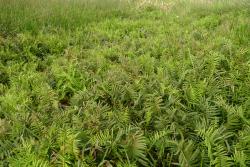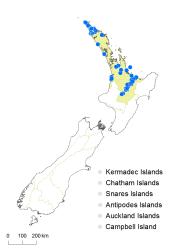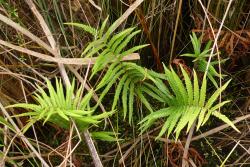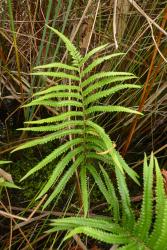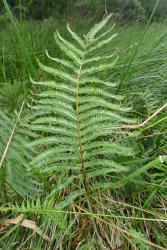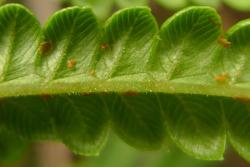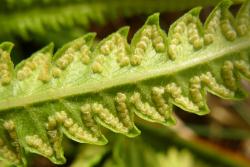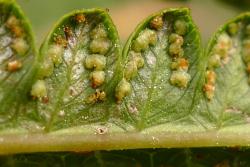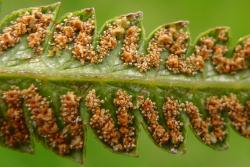- Taxon
- Gallery
- ≡ Pteris interrupta Willd., Phytographia 13, t. 10, f. 1 (1794)
- ≡ Thelypteris interrupta (Willd.) K.Iwats., J. Jap. Bot. 38: 314 (1963)
- = Nephrodium propinquum R.Br., Prodr. Fl. Nov. Holland. 148 (1810)
- = Nephrodium inaequilaterum Colenso, Trans. & Proc. New Zealand Inst. 20: 229 (1888)
Rhizomes long-creeping, up to 115 mm long (in herbarium specimens) with stipes arising 5–30 mm apart, 1.5–4 mm diameter, bearing scattered scales. Rhizome scales ovate to broadly ovate, 1–3 mm long, 0.5–1.5 mm wide, pale to dark brown, entire. Fronds 225–1450 mm long, held stiffly upright. Stipes 120–970 mm long, yellow-brown to chestnut-brown, almost black at base, glabrous or scaly near base, slightly polished. Laminae 1-pinnate, usually elliptic or ovate, sometimes narrowly, rarely broadly so, abruptly narrowed to a pinnatifid apex, 115–580 mm long, 35–215 mm wide, dull green on both surfaces or sometimes lighter on abaxial surface, coriaceous. Ovate or broadly ovate, pale brown scales with hairy margins on abaxial surface of pinna midribs and costae; colourless, acicular hairs up to 0.4 mm long on both surfaces of the costae and veins; spherical orange glands variably present on abaxial surfaces of costae and veins. Primary pinnae in 6–18 pairs below the pinnatifid apex, widely spaced especially proximally, narrowly elliptic; the longest at or below the middle, short-stalked, 42–150 mm long, 6–18 mm wide; the basal pair not or scarcely reduced in length. Primary pinnae divided ⅓ to ½ to the midrib; ultimate segments 3–10 mm long, 2.5–6 mm wide; apices acute and bluntly apiculate, margins entire. Basal veins on adjacent pinna segments joining, unbranched in each ultimate pinna segment. Sori round, in one row either side of midrib away from pinna margins; indusia reniform, 0.5–0.9 mm diameter, bearing acicular or rarely capitate hairs or almost glabrous.
Cyclosorus interruptus is recognised by its long-creeping rhizomes, erect and leathery fronds, primary pinnae divided one-third to halfway to the midrib with acute segments, basal pair of pinnae not shortened, veins in adjacent segments joining, indumentum on the abaxial lamina surfaces comprising broad scales, acicular hairs and spherical orange glands, and indusia usually bearing acicular hairs or sometimes glabrous. Plants vary considerably in size; the largest, with greatly extended stipes (longer than the laminae), occur in swamps in the Far North, whilst stunted plants are found on thermal soils in the central North Island with much smaller fronds and shorter rhizomes.
North Island: Northland, Auckland, Volcanic Plateau.
Altitudinal range: 0–600 m.
Cyclosorus interruptus occurs in coastal and lowland areas of the North Island from Te Paki to Kāwhia and the Bay of Plenty, and throughout the geothermal region from Whakatāne to Tokaanu where it extends locally into montane areas. It grows from sea level to about 600 m near Wairakei.
Also widespread in the tropics and subtropics of the Americas, Africa, India, Asia, Australia and most of the islands of the Pacific, including Hawai‘i.
Occurs in swamps, on peaty soils and lake margins in the northern part of its distribution, and on heated soil near hot springs and streams, or in swamps, in geothermal regions, sometimes under mānuka, and kānuka. In the Waikato it is also found under willows (Salix cinerea and S. fragilis). It is often associated with Typha orientalis, Phormium tenax, Isachne globosa, Machaerina juncea, Carex spp., Juncus spp., Schoenus brevifolius, Thelypteris confluens and Blechnum minus, and with Christella dentata, Lycopodiella cernua and Nephrolepis flexuosa in thermal areas.
The species was given a conservation status of 'At Risk / Declining' by de Lange et al. (2018).
Leach (2005) suggested that Cyclosorus interruptus might have been introduced to New Zealand by early Polynesian settlers, because it grows in abandoned taro pondfields in the Pacific Islands and could have been introduced with taro. Against this is the likelihood of self-dispersal, given the large number of fern species that are indigenous to New Zealand and shared with Australia and/or the Pacific Islands.
n = 36 (Brownlie 1961, as Cyclosorus gongylodes).
The names Polypodium unitum L. and Aspidium gongylodes Schkuhr, and combinations based on them used in earlier Flora treatments (notably Nephrodium unitum, Cyclosorus gongylodes, Dryopteris gongylodes and Thelypteris gongylodes) are misidentifications of Cyclosorus interruptus (see Holttum 1977; Bostock 1998).
A collection made by J.G. Klein from southern India (B-W 19770) was designated as the lectotype for Pteris interrupta by Fosberg & Sachet (1972). This choice was challenged by Mazumdar (2016) who suggested that the specimen was collected after Willdenow’s publication of the name in 1794. Mazumdar instead designated a plate of P. interrupta in Willdenow’s protologue (t. 10, f. 1) as the lectotype. This interpretation was rejected by Fraser-Jenkins et al. (2017) who maintained that the date of collection was uncertain, and that the original choice should stand.



